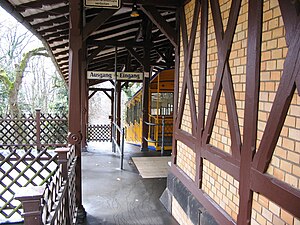| Nerobergbahn | ||||||||||||||||||||||||||||||||||||||||||||||||||||||
|---|---|---|---|---|---|---|---|---|---|---|---|---|---|---|---|---|---|---|---|---|---|---|---|---|---|---|---|---|---|---|---|---|---|---|---|---|---|---|---|---|---|---|---|---|---|---|---|---|---|---|---|---|---|---|
 The viaduct The viaduct | ||||||||||||||||||||||||||||||||||||||||||||||||||||||
| Overview | ||||||||||||||||||||||||||||||||||||||||||||||||||||||
| Owner | ESWE Verkehrsgesellschaft mbH | |||||||||||||||||||||||||||||||||||||||||||||||||||||
| Locale | Wiesbaden, Germany | |||||||||||||||||||||||||||||||||||||||||||||||||||||
| Stations | 2 | |||||||||||||||||||||||||||||||||||||||||||||||||||||
| Website | www | |||||||||||||||||||||||||||||||||||||||||||||||||||||
| Service | ||||||||||||||||||||||||||||||||||||||||||||||||||||||
| Type | funicular railway | |||||||||||||||||||||||||||||||||||||||||||||||||||||
| Rolling stock | 2 × 50-passenger cars | |||||||||||||||||||||||||||||||||||||||||||||||||||||
| History | ||||||||||||||||||||||||||||||||||||||||||||||||||||||
| Opened | 1888 (1888) | |||||||||||||||||||||||||||||||||||||||||||||||||||||
| Closed | 1944 (1944) | |||||||||||||||||||||||||||||||||||||||||||||||||||||
| Reopened | 1948 (1948) | |||||||||||||||||||||||||||||||||||||||||||||||||||||
| Technical | ||||||||||||||||||||||||||||||||||||||||||||||||||||||
| Line length | 440 metres (1,444 ft) | |||||||||||||||||||||||||||||||||||||||||||||||||||||
| Number of tracks | 2, common centre rail | |||||||||||||||||||||||||||||||||||||||||||||||||||||
| Track gauge | 1,000 mm (3 ft 3+3⁄8 in) metre gauge | |||||||||||||||||||||||||||||||||||||||||||||||||||||
| Operating speed | 2 metres per second (6.6 ft/s) | |||||||||||||||||||||||||||||||||||||||||||||||||||||
| Highest elevation | 80 metres (262 ft) | |||||||||||||||||||||||||||||||||||||||||||||||||||||
| ||||||||||||||||||||||||||||||||||||||||||||||||||||||
The Nerobergbahn is a funicular railway in Wiesbaden, Germany. The line links the city, with a station at the north of the Nerotalanlagen, with the Neroberg hill to its north, which offers a panorama view.
History
The line opened in 1888, and is one of the few funiculars employing water propulsion. At the upper station, tanks on the downhill car are filled with up to 7,000 litres (1,500 imp gal; 1,800 US gal) of water to ensure that it is heavier than the uphill car. The downhill car then pulls the uphill car uphill with a 452-metre (1,483 ft) long steel cable. When the downhill carriage arrives at the lower station, the water is discharged and pumped uphill.
In 1939, it was planned to convert the line to electric propulsion and to provide larger cars, but the outbreak of World War II prevented this. The line was taken out of service in 1944 due to war damage, and service was restarted in 1948. In 1988 the line was protected as a technical monument by the State of Hesse.
Specifications
The funicular has the following technical parameters:
- Maximum gradient: 26%
- Average gradient: 19%
- Journey time: 3.5 minutes
- Traction: Water ballast
Gallery
See also
References
- ^ "Nerobergbahn". Nerobergbahn. Archived from the original on 25 May 2007. Retrieved 23 February 2007.
- "Die Nerobergbahn" [The Nerobergbahn] (in German). Nerobergbahn. Retrieved 18 February 2011.
- "Lift-Database : Wiesbaden : Nerobergbahn". Lift-World.info. Archived from the original on 27 September 2007. Retrieved 23 February 2007.
Bibliography
- Kopp, Klaus (2000). 125 Jahre Wiesbadener Verkehrsbetriebe 1875-2000. Wiesbaden: ESWE-Verkehrsgesellschaft mbH. ISBN 9783980128827.
External links
- [REDACTED] Media related to Nerobergbahn at Wikimedia Commons
- Official website (in English)
50°05′40.79″N 8°13′31.76″E / 50.0946639°N 8.2254889°E / 50.0946639; 8.2254889
Categories:
